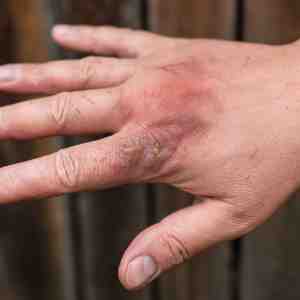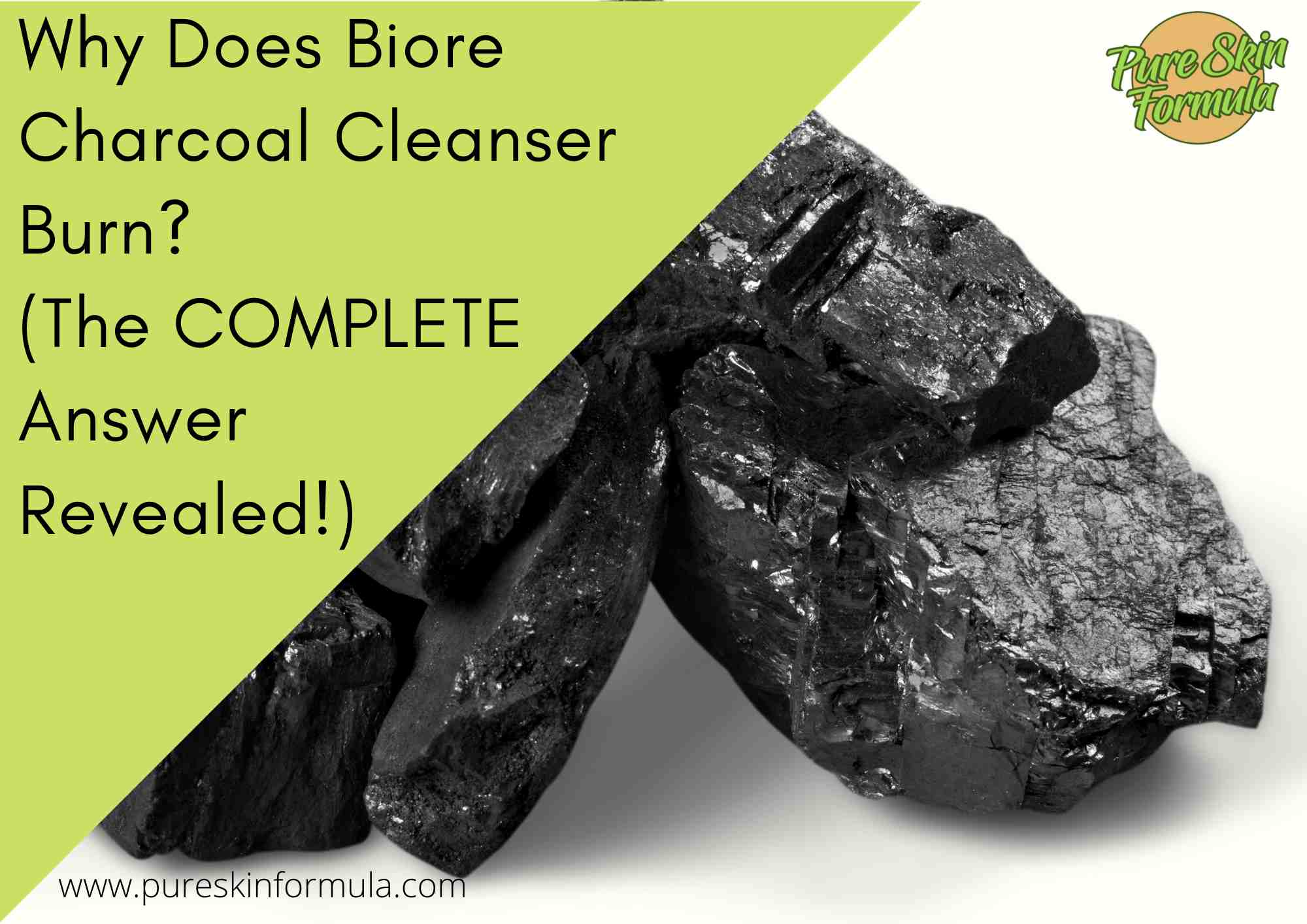Let’s face it – you’re diligently applying your trusted cleanser, and suddenly, a subtle warmth turns into an unexpected heat. What’s behind this sensation contradicting the promised bliss of a cleansed complexion?
In this exploration, we unravel the science, diving into the depths of Biore’s Charcoal Cleanser to understand why it’s not all cool and refreshing for some. Together, we’ll journey through the intricacies of ingredients, the dance between pH levels and skin oils, and the unique sensitivities that make skincare far from a one-size-fits-all affair.
Let’s start!
Why does Biore charcoal cleanser burn?
Biore Charcoal Cleanser may cause a burning sensation due to its active ingredients and individual skin reactions. The cleanser contains charcoal, known for its deep-cleansing properties, and other active components that can alter skin pH and interact with natural oils.
Factors such as overuse, incorrect application techniques, and pre-existing skin conditions may contribute to the burning sensation. Skin sensitivity varies among people, with some experiencing irritation or allergic reactions.
To minimize discomfort, you can patch-test the product, adjust application frequency, and seek professional advice.
Let’s dig deeper into this!
Understanding Biore Charcoal cleanser
At the heart of Biore Charcoal Cleanser lies the transformative power of activated charcoal. This form of carbon has been harnessed for its unparalleled ability to absorb impurities, making it a beacon in the skincare industry.
Activated charcoal acts like a magnet, drawing out dirt, excess oil, and toxins from the skin’s pores. Its porous structure enhances its absorption capacity, providing a deep and thorough cleanse that goes beyond the surface.
This unique characteristic makes charcoal a prized ingredient for those seeking to unclog pores and achieve a refreshed complexion.
The benefits of charcoal extend beyond cleansing. Its natural antibacterial and anti-inflammatory properties make it an ally against acne and blemishes, offering users the potential for clearer, healthier skin.

While charcoal is undoubtedly a star player, understanding its interaction with other ingredients is crucial for comprehending how Biore Charcoal Cleanser achieves its skincare goals.
Beyond charcoal, this product incorporates a thoughtfully curated blend of active components, each contributing to the product’s overall efficacy. Ingredients like salicylic acid, glycerin, and menthol enhance the cleansing experience.
Salicylic acid, a beta-hydroxy acid (BHA), complements charcoal’s purifying action by exfoliating the skin’s surface. This helps prevent and treat acne, promoting a smoother texture.
Glycerin, a hydrating agent, ensures the skin’s natural moisture balance is maintained while the cleanser works magic. This prevents the common pitfall of over-drying, ensuring a thorough cleanse without compromising skin health.
With its cooling properties, Menthol adds a sensory element to the cleansing process, leaving a refreshing sensation. While these additional components enhance the product’s performance, they can also influence how the cleanser interacts with individual skin types.
The science behind the burn
Let’s start with the chemical reactions between ingredients and skin.
The pH levels of skincare products play a pivotal role in determining their compatibility with the skin’s natural acid mantle. Biore Charcoal Cleanser can slightly alter the skin’s pH, leading to a tingling or burning sensation for some users.

The skin thrives in a slightly acidic environment, maintaining its integrity and defense against harmful microorganisms. Any deviation from this delicate balance can trigger reactions and, in some cases, a burning sensation.
The interaction between the cleanser and the skin’s natural oils adds another layer to the chemical complexity. While the product aims to remove excess oil and impurities, it may inadvertently disrupt the skin’s lipid barrier. This can lead to a temporary warmth or burning sensation, especially in people with more sensitive skin types.
The uniqueness of each person’s skin means that what one might perceive as a mild tingling sensation, another may interpret as an uncomfortable burn. Factors like allergies or pre-existing skin conditions further amplify sensitivity.
Identifying these specific triggers and understanding individual skin thresholds is crucial in deciphering whether the burning sensation is a natural response or an indication of a more severe reaction.
Potential causes of the burning sensation
One common factor that can intensify the burning sensation is the overuse or improper application of Biore Charcoal Cleanser.
While the allure of a deeply cleansed complexion is understandable, exceeding the recommended frequency or using an excessive amount of the product can disrupt the skin’s equilibrium.

The active ingredients, particularly charcoal and salicylic acid, may exert their effects more intensely when used excessively, leading to a heightened sensation of warmth.
Equally significant is the way the cleanser is applied. Vigorous rubbing or scrubbing may exacerbate the burning sensation, increasing friction and potentially irritating the skin.
Gentle, circular motions during application can ensure a thorough cleanse without subjecting the skin to unnecessary stress.
People with pre-existing skin conditions, such as eczema, psoriasis, or rosacea, may find that these conditions amplify the burning sensation when using Biore Charcoal Cleanser. Skin disorders often compromise the skin barrier, making it more susceptible to reactions from active ingredients.
Sensitivity to certain ingredients becomes crucial in this context. For instance, people with rosacea may find that the menthol content in the cleanser exacerbates redness and irritation.
Those with eczema might experience increased dryness or itching. Recognizing these pre-existing conditions and their potential interaction with the cleanser is fundamental for making informed choices about product suitability.
Tips for safe and effective use
A patch test is essential before integrating Biore Charcoal Cleanser into your daily skincare routine. Applying a small amount of the cleanser on a discreet area of your skin allows you to assess how your skin reacts to its ingredients. This precautionary measure helps identify any immediate adverse reactions.
The frequency of using Biore Charcoal Cleanser matters. While some may find daily application suitable, others with more sensitive skin benefit from a less frequent routine.
Observing how your skin responds after each use enables you to tailor the application frequency to your skin’s needs. If you experience persistent warmth or a burning sensation, consider reducing the frequency of use.
When we have sensitive skin or are prone to skin conditions, seeking professional advice is prudent. Dermatologists can provide personalized insights based on your skin’s needs and vulnerabilities. They can recommend alternative products or adjustments to your skincare routine to mitigate the risk of a burning sensation.
Addressing common myths and misconceptions
One prevalent misconception surrounding skincare products, including Biore Charcoal Cleanser, is the confusion between a mild tingling sensation and a genuine burning feeling.
Not all sensations are created equal; understanding this nuance is crucial for users. A tingling sensation, often associated with active ingredients penetrating the skin, can be a normal response. It may signify that the product cleans and revitalizes the skin.
Genuine burning is typically more intense and uncomfortable. It may manifest as redness, stinging, or persistent warmth that extends beyond a momentary tingle. Recognizing the difference helps users gauge whether the sensation aligns with the expected effects of the product or if it hints at an adverse reaction.

In the digital age, where information spreads rapidly, misconceptions about product safety can proliferate. Biore Charcoal Cleanser, with its powerful ingredients, has not been immune to such misconceptions.
Some users may express concerns about the product’s safety based on anecdotal accounts or misinterpretations of its intended effects. It’s crucial to rely on verified information, including official product descriptions, ingredient lists, and guidance from dermatological experts.
Biore, as a reputable skincare brand, adheres to rigorous quality standards. Including active ingredients is a deliberate choice to provide effective skincare solutions.
Users are encouraged to consult official sources, product labels, and professional skincare advice to make informed decisions about the safety of Biore Charcoal Cleanser for their unique skin needs.
Another common misconception is uncertainty about when to discontinue applying Biore Charcoal Cleanser. Users may be unsure if a persistent burning sensation is normal during the adjustment period or if it signals a more severe issue.
Clarity on this matter is crucial for ensuring the health and comfort of the skin. While a mild tingling sensation during initial use may be expected as the skin adjusts, persistent and uncomfortable burning is a signal to reconsider the product’s suitability.
Biore’s response to consumer concerns
As a reputable skincare brand, Biore prioritizes a strong and transparent relationship with its consumers. Understanding that individual experiences may vary, Biore has established robust customer support mechanisms to address user concerns effectively.

This typically involves accessible channels such as customer helplines, email support, and, in some cases, social media platforms. Users can seek guidance, express concerns, and receive personalized assistance through these channels, contributing to an open dialogue between the brand and its consumers.
In response to user concerns about the burning sensation associated with Biore Charcoal Cleanser, the brand may issue official statements to provide clarity and guidance.
These statements can be found on the brand’s official website, in product packaging, or through other communication channels. Biore’s statements typically aim to demystify the reasons behind the burning sensation, offering insights into the product’s formulation, intended effects, and recommended usage.
Official statements often emphasize the importance of following the product’s instructions, including patch testing and adjusting application frequency based on individual skin responses.
Additionally, Biore may highlight the steps users can take to alleviate the burning sensation, such as incorporating a moisturizer or reducing the frequency of use.
Conclusion
We’ve dissected the science behind the tingle, debunked myths, and uncovered Biore’s commitment to user satisfaction. Embrace the power of knowledge to tailor your skincare routine.
Conduct a patch test, adjust usage based on your skin’s unique response, and seek professional guidance. Take this knowledge, let it empower you, and embark on your skincare journey with confidence and vitality.
Thank you for reading!
Valeria







